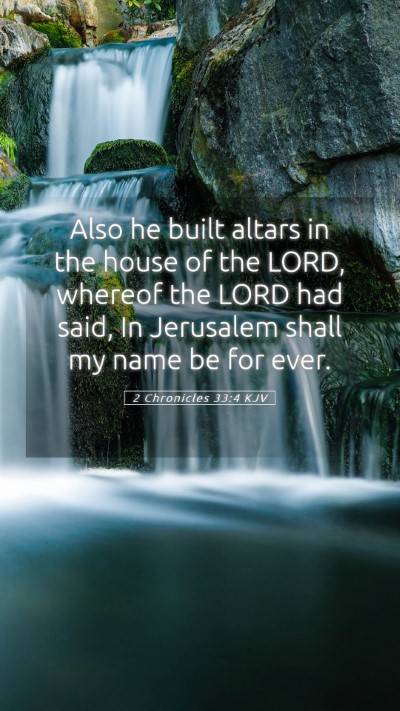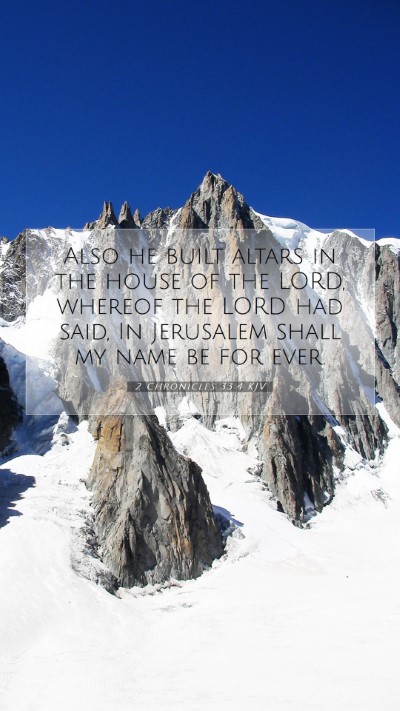Understanding 2 Chronicles 33:4
Bible Verse: 2 Chronicles 33:4
In this verse, we see a clear directive regarding King Manasseh's actions in Jerusalem. He sought to build high places, which are places of worship, and particularly in the hill country of Judah. These actions have profound implications for both the religious practices of the time and the spiritual condition of the people.
Summary of Commentary Insights
This analysis draws upon public domain commentaries by Matthew Henry, Albert Barnes, and Adam Clarke to provide a comprehensive understanding of this passage.
Matthew Henry's Commentary
Matthew Henry highlights that Manasseh's establishment of high places during his reign directly contradicts the worship of the true God. He notes that these acts reflect a regression into idolatry, which was a recurring theme in Israel's history. High places were often sites for pagan worship, which endangered the spiritual integrity of the people. Henry emphasizes the seriousness of leading a nation away from God, suggesting that such leadership requires accountability and ultimately has consequences for the broader community.
Albert Barnes' Commentary
Albert Barnes elaborates on the significance of high places in ancient Israel. He explains that while there were provisions for worshiping God at the Temple in Jerusalem, many ignored this command and worshiped on the high places, which represented a compromise and a failure to adhere to God's laws. Barnes points out that the construction of these altars was an affront to the unity of worship that God desired from His people. He sees this as a deviation that sets a dangerous precedent for the nation.
Adam Clarke's Commentary
Adam Clarke takes a more historical perspective, providing context for why high places were important in the ancient Near East. He suggests that Manasseh's actions were partially influenced by surrounding cultures that practiced various forms of worship. Clarke argues that the verse serves as a reminder of the dangers of syncretism—blending different religious practices—which can lead God’s people away from the truth. He also expresses a hope that subsequent generations would seek repentance and return to rightful worship as a result of such deviances.
Key Themes and Applications
- The Danger of Idolatry: This verse serves as a critical reminder of the dangers associated with idol worship, as evidenced by King Manasseh's actions.
- Historical Context: Understanding the historical backdrop provides depth to the practices seen in ancient Israel, enhancing our Bible verse understanding.
- Leadership Accountability: The verse suggests that leaders have a profound influence over their followers, stressing the need for righteous leadership.
- Worship Practices: It emphasizes the importance of maintaining appropriate worship practices centered on the true God.
- Call to Repentance: The potential for future repentance highlights God's mercy and the enduring hope for restoration among His people.
Cross References
- 2 Kings 21:3 - Details on the actions of Manasseh and his construction of altars.
- Jeremiah 32:34 - God’s condemnation of turning away from Him for idolatrous practices.
- Deuteronomy 12:2-4 - Instructions about the destruction of high places by the Israelites.
- 1 Kings 14:23 - The role of high places in the downfall of Israel.
- 2 Chronicles 33:9 - Further elaboration on the consequences of Manasseh's actions.
Conclusion
In summary, 2 Chronicles 33:4 encapsulates complex themes of idolatry, the nature of worship, and leadership influence within the biblical narrative. It serves as both a warning and a call to righteousness, echoing throughout scripture and urging contemporary readers to examine their understanding of worship and to pursue faithful adherence to God’s commandments. By engaging with detailed scripture analysis and commentary, individuals can deepen their Bible study insights and apply these lessons to their lives effectively.


